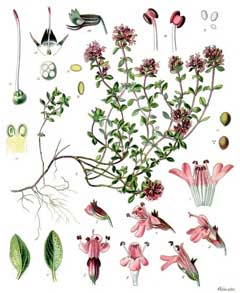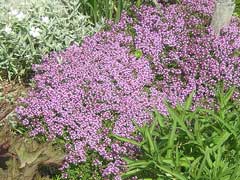 |
|
http://commons.wikimedia.org/wiki/File:Koeh-138.jpg |
 |
|
Translate this page:
Summary
Wild Thyme (T. serpyllum) tolerates light treading and grows well between stepping stones on paths and in walls. Leaves are used raw in salads or added as a flavouring to cooked foods. Bloom Color: Purple. Main Bloom Time: Early summer. Form: Prostrate, Spreading or horizontal.
Physical Characteristics

 Thymus_serpyllum is an evergreen Shrub growing to 0.1 m (0ft 4in) by 0.3 m (1ft) at a medium rate.
Thymus_serpyllum is an evergreen Shrub growing to 0.1 m (0ft 4in) by 0.3 m (1ft) at a medium rate.
See above for USDA hardiness. It is hardy to UK zone 5 and is not frost tender. It is in leaf all year, in flower from July to August, and the seeds ripen from August to September. The species is hermaphrodite (has both male and female organs) and is pollinated by Bees, flies, Lepidoptera (Moths & Butterflies). The plant is self-fertile.
It is noted for attracting wildlife.
Suitable for: light (sandy) and medium (loamy) soils and prefers well-drained soil. Suitable pH: mildly acid, neutral and basic (mildly alkaline) soils. It cannot grow in the shade. It prefers dry or moist soil. The plant can tolerates strong winds but not maritime exposure.
UK Hardiness Map
US Hardiness Map
Synonyms
T. angustifolius.
Plant Habitats
Edible Uses
Leaves - raw in salads or added as a flavouring to cooked foods[2, 11, 46, 61]. Thyme retains its flavour well in long slow cooking. If the leaves are to be dried, the plants should be harvested in early and late summer just before the flowers open and the leaves should be dried quickly[200]. An aromatic tea is made from the leaves[21].
References More on Edible Uses
Medicinal Uses
Plants For A Future can not take any responsibility for any adverse effects from the use of plants. Always seek advice from a professional before using a plant medicinally.
Wild thyme is a commonly used domestic remedy, being employed especially for its antiseptic properties and its beneficial effect on the digestive system. The whole plant is anthelmintic, strongly antiseptic, antispasmodic, carminative, deodorant, diaphoretic, disinfectant, expectorant, sedative and tonic[4, 165, 200, 238, 254]. It is taken internally in the treatment of bronchitis, catarrh, laryngitis, flatulent indigestion, painful menstruation, colic and hangovers[238]. It is said to be effective in treating alcoholism[238]. It should not be prescribed for pregnant women[238]. Externally, it is applied to minor injuries, mastitis, mouth, throat and gum infections etc[238]. The plant can be used fresh at any time of the year, or it can be harvested as it comes into flower and either be distilled for the oil or dried for later use[238]. The seeds are used as a vermifuge[240]. Wild thyme contains all the medicinal properties of the more commonly used garden thyme (T. vulgaris), though in a lesser degree[4]. An essential oil distilled from the leaves is used in the treatment of stress-related conditions, though it can cause allergic reactions[238].
References More on Medicinal Uses
The Bookshop: Edible Plant Books
Our Latest books on Perennial Plants For Food Forests and Permaculture Gardens in paperback or digital formats.

Edible Tropical Plants
Food Forest Plants for Hotter Conditions: 250+ Plants For Tropical Food Forests & Permaculture Gardens.
More

Edible Temperate Plants
Plants for Your Food Forest: 500 Plants for Temperate Food Forests & Permaculture Gardens.
More

More Books
PFAF have eight books available in paperback and digital formats. Browse the shop for more information.
Shop Now
Other Uses
Agroforestry uses:
Thyme can be used as a ground cover and is beneficial for attracting pollinators. Its aromatic properties may also repel certain pests, making it a useful companion plant in gardens.
Landscape Uses:Container, Ground cover, Rock garden, Seashore. An essential oil from the leaves and flowering tops is used in perfumery, soaps, medicinally etc. It has fungicidal and disinfectant properties[4, 7]. About 150 grams of oil are obtained from 100 kilos of plant material[4]. The dried flowers are used to repel moths from clothing[4]. The growing plant is said to repel cabbage root fly[18, 20]. A good ground cover for a sunny position[197]. It needs weeding for the first year or so[197]. Plants are best spaced about 45cm apart each way[208]. Plants are only satisfactory when young or growing luxuriantly - they are apt to become bare in patches otherwise[208]. Summer flowers bring bees. Perennial groundcover for zone 2 firebreaks. The US government has created a system of firebreaks for areas prone to wildfires, theses are separated into concentric zones surrounding buildings. Zone 2 is the second away from the house. These low-level groundcovers provide little fuel. 1. Nectary - Flowers rich in nectar and pollen:
Yes – Thyme flowers are rich in nectar and pollen, making them attractive to pollinators like bees and butterflies.
2. Wildlife - Food (Fruit, Seeds, Leaf litter, Shelter, Nesting, Roosting):
Yes – While thyme does not produce significant fruit, its leaves are edible for many herbivores and insects. The dense foliage can also provide shelter for small wildlife.
3. Invertebrate Shelter (Overwintering sites, Leaf litter, Groundcover):
Yes – Thyme can offer shelter for beneficial insects, and its groundcover can protect invertebrates during the winter months.
4. Pest Confuser (Smell):
Yes – The strong aroma of thyme can confuse or repel pests, making it a beneficial companion plant in gardens.
Special Uses
References More on Other Uses
Cultivation details
Requires a light well-drained preferably calcareous soil in a sunny position[1, 200]. Succeeds in dry soils[4]. Grows well between stepping stones on paths, tolerating light treading[183, 200]. Succeeds on walls. Thymes dislike wet conditions, especially in the winter. A layer of gravel on the soil around them will help protect the foliage from wet soils[238]. Plants are hardy to about -15°c[200]. This is a very difficult genus taxonomically, the species hybridize freely with each other and often intergrade into each other[200]. This species is harvested commercially for its essential oil, known as 'wild thyme'[218]. Closely related to T. praecox arcticus, but this species is not so common in Britain[11]. It is a very polymorphic plant. A good companion for most other plants[54], it makes a very good carpeting plant for the rockery or between paving stones[1] and can also be grown in a short lawn[54]. The flowers are rich in nectar and are very attractive to honey bees[200], the plant also attracts butterflies[4, 7, 24]. Special Features:Attractive foliage, Edible, Fragrant foliage, Not North American native, Suitable for dried flowers. Heat Zone 9-1. Thyme is typically harvested in late spring to early summer, just before the plant flowers for the best flavor.
Thyme usually flowers in late spring to early summer, generally from June to August (Northern Hemisphere). Thyme is considered a slow to moderate grower, reaching maturity in about 1 to 2 years under optimal conditions.
References Carbon Farming Information and Carbon Sequestration Information
Temperature Converter
Type a value in the Celsius field to convert the value to Fahrenheit:
Fahrenheit:
The PFAF Bookshop
Plants For A Future have a number of books available in paperback and digital form. Book titles include Edible Plants, Edible Perennials, Edible Trees,Edible Shrubs, Woodland Gardening, and Temperate Food Forest Plants. Our new book is Food Forest Plants For Hotter Conditions (Tropical and Sub-Tropical).
Shop Now
Plant Propagation
Seed - sow spring in a cold frame. Seed can also be sown in autumn in a greenhouse. Surface sow or barely cover the seed. Germination can be erratic. When they are large enough to handle, prick the seedlings out into individual pots and grow them on in the greenhouse for at least their first winter. Plant them out into their permanent positions in late spring or early summer, after the last expected frosts. Division in spring or autumn[200]. Larger divisions can be planted out direct into their permanent positions. We have found that it is best to pot up smaller divisions and grow them on in light shade in a greenhouse or cold frame until they are growing away well. Plant them out in the summer or the following spring. Cuttings of young shoots, 5 - 8cm with a heel, May/June in a frame[200]. Cuttings of half-ripe wood, 5 - 8cm with a heel, July/August in a frame[200]. Layering.
Other Names
If available other names are mentioned here
Creeping thyme. Balma jhar, Banajawain, Csombor, Cubra, Kakukkbora, Kalandar zatar, Marizha, Masho, Rang sbur, Samon-phyu-yaing, Shakei, Wild thyme,
Native Range
TEMPERATE ASIA: Russian Federation-Western Siberia (Western Siberia), Russian Federation-Eastern Siberia (Eastern Siberia (Dauria)) EUROPE: Denmark, Finland, United Kingdom, Norway, Sweden, Czechoslovakia, Austria (north), Belgium, Germany, Hungary, Netherlands, Poland, Russian Federation (European part), Belarus, Estonia, Lithuania, Latvia, Ukraine (north), Former Yugoslavia (north), France (northeast)
Weed Potential
Right plant wrong place. We are currently updating this section.
Please note that a plant may be invasive in one area but may not in your area so it's worth checking.
Conservation Status
IUCN Red List of Threatened Plants Status :

Growth: S = slow M = medium F = fast. Soil: L = light (sandy) M = medium H = heavy (clay). pH: A = acid N = neutral B = basic (alkaline). Shade: F = full shade S = semi-shade N = no shade. Moisture: D = dry M = Moist We = wet Wa = water.
Now available:
Food Forest Plants for Mediterranean Conditions
350+ Perennial Plants For Mediterranean and Drier Food Forests and Permaculture Gardens.
[Paperback and eBook]
This is the third in Plants For A Future's series of plant guides for food forests tailored to
specific climate zones. Following volumes on temperate and tropical ecosystems, this book focuses
on species suited to Mediterranean conditions—regions with hot, dry summers and cool, wet winters,
often facing the added challenge of climate change.
Read More
Expert comment
Author
L.
Botanical References
1117200
Links / References
For a list of references used on this page please go here
Readers comment